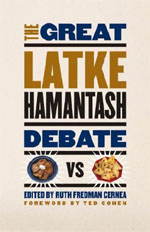 The Great Latke Hamantaschen Debate sounds like a bunch of nonsense, but at least it’s academic nonsense: It began as “fireside schmooze” to give Jewish students a sense of ethnic pride in 1946, and students and professors at the University of Chicago have taken on the least pressing philosophical conundrum of our time, subjecting two famous Jewish noshes to the rigors of proof and the rules of debate every year since.
The Great Latke Hamantaschen Debate sounds like a bunch of nonsense, but at least it’s academic nonsense: It began as “fireside schmooze” to give Jewish students a sense of ethnic pride in 1946, and students and professors at the University of Chicago have taken on the least pressing philosophical conundrum of our time, subjecting two famous Jewish noshes to the rigors of proof and the rules of debate every year since.
An excerpt from the lecture Consolations of Latkes by Ted Cohen:
In every possible world, there is a latke. How do we know this? By discovering that it is impossible to imagine a world in which there is no latke. Try it. First, imagine a world. Put in everything you need for a world; this is to be a whole world, not a fragment. Now add in a latke. Now take that latke out. It cannot be done, can it?
The ongoing debate now has it’s own tongue-in-cheek (and perhaps, mouth-watering) academic treatise, including papers such as “The Latkes Role in the Renaissance,” “The Hermeneutics of the Hamantash” and other high-minded logic.
Ruth Fredman Cernea, the book’s author, explains that “The things that make this what it is are so deep in Jewish tradition – being able to laugh at yourself, being able to laugh at the seriousness of life. In Jewish tradition, scholarship is serious, but it’s also irreverent.”

I once heard a lovely bit of Purim Torah that claimed that the hamantash, with its three sides was suspect as a Jewish symbol and that the latke was to be greatly preferred.